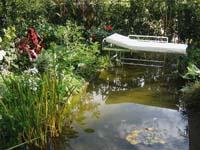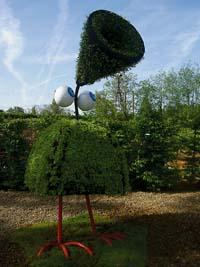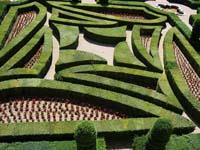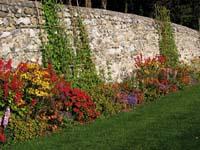Gardens, the man seeks the feeling

In the present gardening everything is worth: the garden can be totally integrated with the environment, in contrast, with or without straight lines, with natural materials or with remains of construction... is more, the presence of flowers and plants is not essential. It does not always stand out that it is human work, designed, but yes, even with natural aspect.
Most daring designs
The festival of Chaumont-sur-Loire, in France, is a magnificent showcase to know what is the most modern gardening. It is an International Festival of Gardens, which every year receives about two hundred garden projects, of which choose and execute twenty, with twenty plots enabled for it, of two hundred square meters each. Designs of daring gardens, new, original, surprising, that are exposed between April and October.
Each year organizers choose a theme and participants design a related garden. The theme chosen for 2006 is as follows: "jostari in the garden".
Participants are usually groups, both professional and school. Normally the team is not composed only of gardeners; architects, landscapers, designers, scenographers, engineers... usually meet specialists from different fields. The jury especially values the multidisciplinarity of the team.
Each group interprets the theme in their own way, using the materials and techniques they want... the only limit -- in addition to the size and budget of the plot, ours -- is that of creativity.

In view of the designs of the house Chaumont, it is clear that the concept of garden is very wide. In 2003, for example, the design by Adrián Geuze was a milestone: among the garden elements were pumpkins and lots of bones.
Chaumont's designs are too bold for someone who may not be accustomed to them, since they do not fall into the classical definition of the garden -- according to the vocabulary, "the garden: the plants, and especially the ornamental flowers, is the land that grows"-. In these designs, nature, in its broadest sense, is totally violated to make art.
It is clear that the current definition of the garden is very broad, and at least one of the main features that combine these new designs is that they generate sensations. Few will be temperate watching this type of gardens.
At the other end, apparently natural
However, the current trends are not always so linked to architecture and the most cutting-edge design, but are more classical, to put it in some way, they are closer to the dictionary definition. The Rosendal garden in Stockholm, for example, is far from the designs of Chaumont, is more conventional. At first glance it seems like a vegetable garden, but soon one realizes that it has a great aesthetic load. Their floral sets, trees, vegetables and so on are not placed. The other way around.
One of the points of attention of the Rosendal Garden is the composting area in which waste is deposited, in most gardens and gardens. It is not by chance, but the importance of the environment today. Because the XXI. If you want to highlight a trend in gardening of the twentieth century, it is the concern and respect for the environment.

As in agriculture, in gardening, more and more importance is given to the environment, so environmental gardening is gaining strength.
Environmental gardening follows the same criteria as ecological agriculture. The plants most adapted to the climate and soil of the place are selected to avoid irrigation and excessive fertilization. And, in addition to plants and soil, the entire ecosystem is taken into account -- the most effective way of not having pests, among others, and, above all, the cleanest, since the lowest use of pesticides is one of the premises of ecological gardening. It is clear, the model is nature. This does not remove that nature is dominated, of course.
However, in the gardens, foreign species remain very common. This seems to be due to English gardening. Many species from the outside have been used and adapted to their climate.
The English gardens look for a natural landscape (it is the "landscape" because human influence is seen). Gardening model known as landscaping XVIII. 20th century, era of Romanticism. The landscapers Kent, Brown and Repton were looking for an ideal world (thinking about the idea of the Greek Arcada), for what established elements of that ideal world: meadows, trees, sheep... In this way they achieved a feeling of natural environment, but the degree of intervention was very high.

The lagoons, the avatars of the meadows, the arrangement of the tree groups through the introduction and exit to the lawn as a framework of the field… everything was designed. The trees, for example, were pruned, but they were only "arranged," not noticed that they were cared for.
The English gardens have been an example of the prosperity of the garden gardens. Gertrude Jekyll has had many followers. XIX. This garden designer from the end of the 20th century and the beginning of the 20th century used an infinite list of plant species that, as an example, carried in memory the English countryside of his childhood, the countryside. For this reason, it introduced plants of countryside in gardens and gardens, among others.
On the other hand, the species provided from more temperate climates to England, in general, contributed less flowers and fruits. To solve it, they grew them against the wall, which accumulates heat and the plant has a more temperate environment to grow. For example, you can see a magnolia on the wall of an English house in full bloom, raised as if it were a climbing plant; and a pear full of sweet fruit against the wall surrounding the orchard.
And the flowers also cultivated them near the wall, concentrated on narrow grounds to take advantage of the protection and heat of the wall. Thus, the mixed roses, lavender, boj, bergenia grew...
"Nature does not love straight lines"

Straight lines are very common in the current gardens. Hedges cut directly or vegetable hedges --art known as topiary, ornamental pruning -, for example, have been borrowed from another gardening model. And it is not always intended to give the natural: During French Rationalism (XVII. The twentieth century), for example, meant that nature was dominated, that man felt superimposed on nature. Remember the garden of Versailles (designed by Andrée le Notre).

Although they apparently designed very different gardens, English landscapers initially drank from the French, and the French, of course, had as an example other designs from earlier gardens, such as those of the Italian Renaissance. Etc.
Each of the elements of a garden (fountain, flowers, light and shade, trees...) can go back in the history of gardens from one style to another. As can be seen, in the present gardens, vestiges of the styles that have been worked before appear. And perhaps that's what has made it so different... If a definition were given, some would always remain outside. One of the characteristics that brings together is that in the gardens man has molded nature to create sensations.
Thanks to Joseba Plazaola, of Mendikoi, for his collaboration in the preparation of the article and for the cession of photographs.








